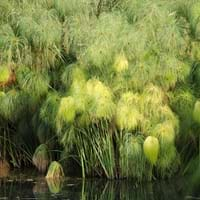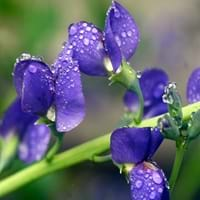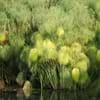Life Span
Perennial
Perennial
Origin
Africa
North America, United States, North-Central United States, Central United States, Canada
Types
C. papyrus, C. papyrus 'Nanus
Blue False Indigo
White False Indigo
Habitat
Lakes, Shores of rivers or lakes, sluggish streams and rivers, Swamps
gardens, Grassland, Warmer regions
USDA Hardiness Zone
7-11
2-8
Sunset Zone
H1, H2, 16, 17, 23, 24
A1, A2, A3, 1a, 1b, 2a, 2b, 3a, 3b, 4, 5, 6, 7, 8, 9
Habit
Clump-Forming
Oval or Rounded
Flower Color Modifier
Bicolor
Not Available
Fruit Color
Brown
Light Green
Leaf Color in Spring
Green, Light Green
Light Green, Gray Green, Gray
Leaf Color in Summer
Green, Light Green
Light Green, Gray Green, Gray
Leaf Color in Fall
Green, Light Green
Light Green, Gray Green, Gray
Leaf Color in Winter
Green, Light Green
Not Available
Leaf Shape
Grass like
Ovate
Plant Season
Spring, Summer, Fall, Winter
Summer, Fall
Sunlight
Full Sun, Partial Sun
Full Sun, Partial Sun, Partial shade
Type of Soil
Clay, Loam, Sand
Loam, Sand
The pH of Soil
Neutral
Neutral, Alkaline
Soil Drainage
Poorly Drained
Well drained
Bloom Time
Indeterminate
Summer, Late Summer, Early Fall
Tolerances
Drought
Drought
Where to Plant?
Container, Ground, Pot
Ground, Pot
How to Plant?
Stem Planting
Seedlings, Stem Planting
Plant Maintenance
Medium
Medium
Watering Requirements
Average Water Needs, Keep ground moist, Requires a lot of watering
Average Water Needs
In Summer
Lots of watering
Lots of watering
In Spring
Moderate
Moderate
In Winter
Average Water
Average Water
Soil pH
Neutral
Neutral, Alkaline
Soil Type
Clay, Loam, Sand
Loam, Sand
Soil Drainage Capacity
Poorly Drained
Well drained
Sun Exposure
Full Sun, Partial Sun
Full Sun, Partial Sun, Partial shade
Pruning
Remove damaged leaves, Remove dead branches, Remove dead leaves
Remove damaged leaves, Remove dead branches, Remove dead leaves
Fertilizers
All-Purpose Liquid Fertilizer
All-Purpose Liquid Fertilizer
Pests and Diseases
fungus
Red blotch
Plant Tolerance
Drought
Drought
Flower Petal Number
Single
Single
Fragrant Bark/Stem
No
Yes
Foliage Texture
Not Available
Fine
Foliage Sheen
Glossy
Matte
Self-Sowing
No
Not Available
Attracts
Flying insects, Hummingbirds
Not Available
Allergy
Not Available
Not Available
Aesthetic Uses
Showy Purposes
Showy Purposes
Beauty Benefits
Not Available
Not Available
Edible Uses
Insignificant
No
Environmental Uses
Air purification
Air purification
Medicinal Uses
Cancer, Heals minor burns, Wounds
Not Available
Part of Plant Used
Stem
Whole plant
Other Uses
Constructing Boats, Used as fuel, Used in paper industry
Used as Ornamental plant
Used As Indoor Plant
Yes
No
Used As Outdoor Plant
Yes
Yes
Garden Design
Bog Garden, Container, Feature Plant, Houseplant, Mixed Border, Water Gardens
Foundation, Mixed Border, Rock Garden, Wall
Botanical Name
CYPERUS 'Wild Spike'
AMORPHA canescens
Common Name
Papyrus, Wild Spike Cyperus
False Indigo
In Hindi
पेपिरस संयंत्र
इंडिगो
In German
ägyptischen Papyrus-Pflanze
falsches Indigo
In French
Papyrus égyptien
faux Indigo
In Spanish
Papiro egipcio
Falso Indigo
In Greek
αιγυπτιακό πάπυρο
Λάθος Indigo
In Portuguese
Papiro egípcio
false Indigo
In Polish
Papiro egipcio
fałsz Indigo
In Latin
CHARTA
falsum indicum
Phylum
Magnoliophyta
Magnoliophyta
Class
Agaricomycetes
Not Available
Family
Cyperaceae
Fabaceae
Clade
Angiosperms, Commelinids, Monocots
Angiosperms, Eudicots, Rosids
Tribe
Cariceae
Not Available
Subfamily
Cyperoideae
Not Available
Number of Species
Not Available
Not Available
Season and Care of Egyptian Papyrus and False Indigo
Season and care of Egyptian Papyrus and False Indigo is important to know. While considering everything about Egyptian Papyrus and False Indigo Care, growing season is an essential factor. Egyptian Papyrus season is Spring, Summer, Fall and Winter and False Indigo season is Spring, Summer, Fall and Winter. The type of soil for Egyptian Papyrus is Clay, Loam, Sand and for False Indigo is Loam, Sand while the PH of soil for Egyptian Papyrus is Neutral and for False Indigo is Neutral, Alkaline.
Egyptian Papyrus and False Indigo Physical Information
Egyptian Papyrus and False Indigo physical information is very important for comparison. Egyptian Papyrus height is 60.00 cm and width 60.00 cm whereas False Indigo height is 60.00 cm and width 120.00 cm. The color specification of Egyptian Papyrus and False Indigo are as follows:
Egyptian Papyrus flower color: Tan
Egyptian Papyrus leaf color: Green and Light Green
False Indigo flower color: Purple
- False Indigo leaf color: Light Green, Gray Green and Gray
Care of Egyptian Papyrus and False Indigo
Care of Egyptian Papyrus and False Indigo include pruning, fertilizers, watering etc. Egyptian Papyrus pruning is done Remove damaged leaves, Remove dead branches and Remove dead leaves and False Indigo pruning is done Remove damaged leaves, Remove dead branches and Remove dead leaves. In summer Egyptian Papyrus needs Lots of watering and in winter, it needs Average Water. Whereas, in summer False Indigo needs Lots of watering and in winter, it needs Average Water.





